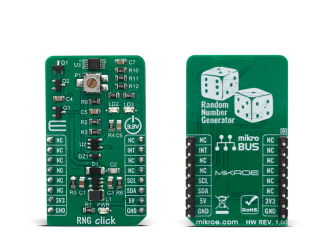
We strongly encourage users to use Package manager for sharing their code on Libstock website, because it boosts your efficiency and leaves the end user with no room for error. [more info]

Rating:
Author: MIKROE
Last Updated: 2020-05-08
Package Version: 1.0.0.0
mikroSDK Library: 1.0.0.0
Category: Encryption
Downloaded: 3477 times
Not followed.
License: MIT license
RNG Click is a random number generator is a device that generates a sequence of numbers or symbols that cannot be reasonably predicted better than by a random chance. This Click board is true hardware random-number generator , which generate genuinely random numbers.
Do you want to subscribe in order to receive notifications regarding "RNG click" changes.
Do you want to unsubscribe in order to stop receiving notifications regarding "RNG click" changes.
Do you want to report abuse regarding "RNG click".


Library Description
Library contains functions for reading voltage.
Key functions:
void rng_write_data ( uint8_t reg_addr, uint16_t reg_data ); - Generic funcion for writing.void rng_set_config ( uint16_t conf_data ); - Function used for set configuration.float rng_get_voltage ( ); - Function used for get voltage.Examples description
The application is composed of three sections :
void application_task ( )
{
char demoText[ 50 ];
float voltage;
voltage = rng_get_voltage();
mikrobus_logWrite( " ~~~> Voltage value: ", _LOG_TEXT );
FloatToStr( voltage , demoText );
mikrobus_logWrite( demoText, _LOG_TEXT );
mikrobus_logWrite( " mV ", _LOG_LINE );
mikrobus_logWrite("_______________________________", _LOG_LINE );
mikrobus_logWrite(" ", _LOG_LINE );
Delay_ms( 1000 );
}
Other mikroE Libraries used in the example:
Additional notes and informations
Depending on the development board you are using, you may need USB UART click, USB UART 2 click or RS232 click to connect to your PC, for development systems with no UART to USB interface available on the board. The terminal available in all MikroElektronika compilers, or any other terminal application of your choice, can be used to read the message.